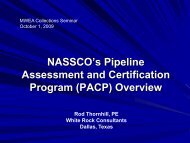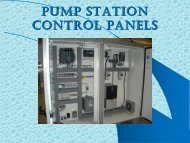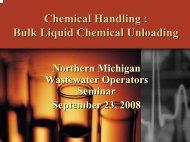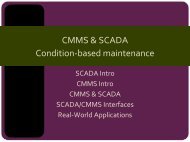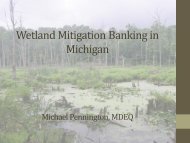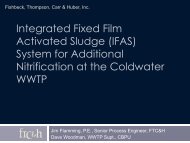Conference - Michigan Water Environment Association
Conference - Michigan Water Environment Association
Conference - Michigan Water Environment Association
Create successful ePaper yourself
Turn your PDF publications into a flip-book with our unique Google optimized e-Paper software.
Are you spending<br />
quality time with your clarifier<br />
Part 2 – Analysis of final clarifier performance<br />
Sam Jeyanayagam, Ph.D., P.E., DEE<br />
Senior Associate, Malcolm Pirnie Inc.<br />
Phone: (614) 430-2611 e-Mail: Sjeyanayagam@pirnie.com<br />
INTRODUCTION<br />
This article outlines tools available to designers and operators<br />
to analyze and predict clarifier behavior based on site-specific<br />
data. Part 1 of this article, which appeared in the last issue of the<br />
Matters, addressed factors impacting final clarifier performance.<br />
Figure 1 illustrates a typical activated sludge system, which<br />
consists of the bioreactor where the biological reactions occur<br />
and the final clarifier, where the biomass is separated from the<br />
wastewater. A relatively small portion of the settled sludge is<br />
wasted from the system to maintain the desired biomass inventory<br />
while the rest is returned to the bioreactor as return activated<br />
sludge (RAS) to seed the incoming wastewater. Consequently, the<br />
performance of the solids separation process is closely linked to the<br />
performance of the biological process and vice versa. The failure<br />
to understand this interdependency has led to poor clarifier design<br />
and operation.<br />
The capacity of a clarifier is related to the rate at which the<br />
incoming solids can be separated and conveyed to the sludge<br />
collection mechanism at the bottom. This rate of solids conveyance<br />
is primarily impacted by the following factors:<br />
Sludge (MLSS) settleability<br />
Operational parameters<br />
• Influent flow rate<br />
• RAS flow rate<br />
• MLSS concentration<br />
Hydraulic characteristics of the clarifier<br />
State point analysis (SPA), is a practical tool available to<br />
designers and operators to examine the behavior of the final<br />
clarifier. It incorporates the impacts of all of the above factors<br />
except the hydraulic characteristics of the clarifier.<br />
STATE POINT ANALYSIS<br />
Solids Flux Theory<br />
The State Point Analysis (SPA), first proposed by Keinath, is an<br />
extension of the solids flux theory, which describes the movement<br />
of solids through a clarifier. In final clarifiers, Type III settling<br />
is the predominant solids removal mechanism (see Part 1 of this<br />
article). Type III settling is characterized by flocculated particles<br />
settling as a zone or blanket. As they settle, the particles maintain<br />
their position relative to each other. The zone settling velocity<br />
(ZSV) is a function of solids concentration (X) and is commonly<br />
expressed by the Vesilind equation:<br />
Figure 1: The Activated Sludge System<br />
GRAVITY SETTLING IN FINAL CLARIFIERS<br />
The activated sludge floc is composed mostly of bacteria, which<br />
constitutes 70 – 80 percent water. In addition, the relatively small<br />
flocs (less than 0.2 mm diameter) formed in the aeration basin<br />
entrap considerable amount of bound water. Hence, the density<br />
difference between the aeration basin floc and water is so small<br />
that solids separation in the clarifier is difficult. Hence, a properly<br />
designed clarifier must encourage flocculation, which results in<br />
larger and heavier particles (less than 0.2 to 2 mm diameter), and<br />
create quiescent conditions for the particles to settle.<br />
ZSV = Vo e-kX (1)<br />
Where Vo and k are settling constants obtained from a series<br />
of settling tests. A good settling sludge is characterized by high<br />
Vo and low k. The solids flux (G), lb/sf/d, represents the mass of<br />
solids transported per unit area of the clarifier per unit time. It<br />
is obtained by multiplying the zone settling velocity by the solids<br />
concentration.<br />
G = (ZSV) X (2)<br />
By combining equations (1) and (2) we obtain:<br />
G = (X) (Voe-kX) (3)<br />
50<br />
MWEA MATTERS: FALL 2005









